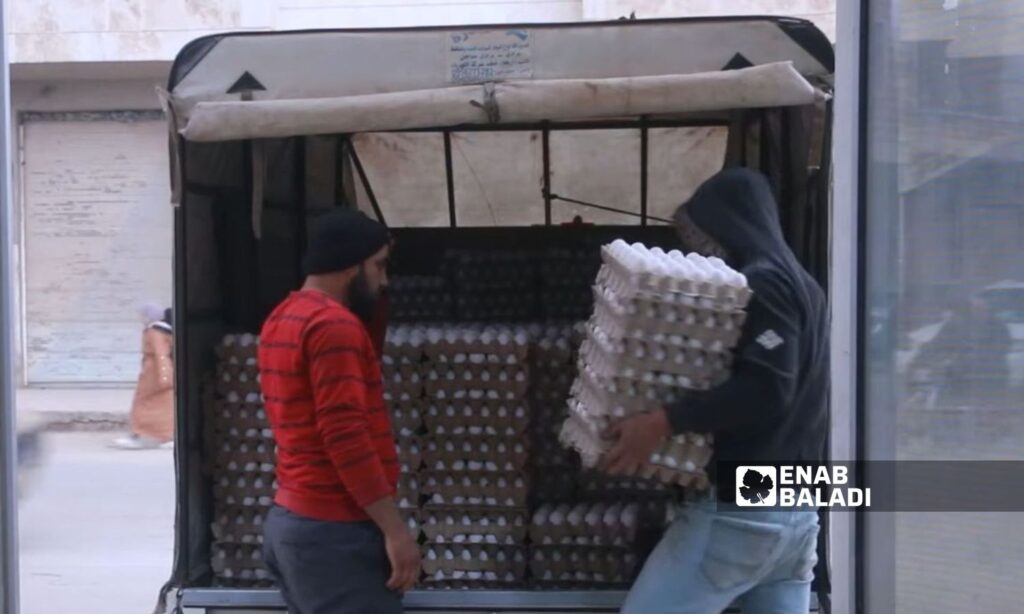Idlib – Anas al-Khouli
Residents in Idlib are complaining about the rise in egg prices and their instability at this time of year, while poultry farm owners attribute the reason to the numerous epidemics affecting chickens and fluctuating temperatures, leading to decreased production.
Abdul Hamid Khattab, 36, tries to provide eggs at least one day a week in his home due to the importance of this food item for children. He says that the current price of one egg, which is three Turkish liras, is high.
Khattab, residing in the city of Idlib and displaced from al-Ghouta, said that the minimum cost of an egg breakfast requires 20 Turkish liras, which is barely enough for his family of five. He considers the price unacceptable compared to the daily wages of workers, which do not exceed 100 Turkish liras.
Khattab’s situation is similar to that of most workers and low-income earners in the city of Idlib, where work is not consistent and done intermittently, and the prices of most goods are high. He notes that it is unfortunate to discuss the price of a commodity like eggs as burdensome today.
According to Enab Baladi‘s questions to three shop owners in Idlib about the demand for eggs, they mentioned that the rise in prices of main foodstuffs, including eggs, led to a change in the consumption culture. Families now buy eggs individually after they used to buy a whole tray and refrigerate it, buying another when the quantity runs out.
A tray of eggs (30 eggs) weighing two kilograms is sold for 75 Turkish liras, while it was sold two weeks ago for 55 Turkish liras. A single egg is sold for three Turkish liras.
The exchange rate of the Turkish lira against the dollar is 32.5 for selling and 32 for buying, according to the Union of Exchangers pricing in Idlib region.
Decrease in egg-producing chickens
Poultry breeders attributed the reasons for this increase to a drop in the number of egg-producing chickens, due to the death of many from common diseases and epidemics this year, along with sharp temperature fluctuations, adversely affecting poultry raising and production costs.
Yasser Juma Zarifa, a poultry farmer in Idlib, told Enab Baladi that the reasons for the high prices of eggs in the region are attributed to the outbreaks of diseases and epidemics affecting poultry farms, killing a third of the layer chickens, which are estimated to be around one million four hundred thousand chickens. These diseases also led to half of the egg production being spoiled, incurring significant losses for poultry breeders.
The farmer added that severe weather fluctuations during the transition periods from summer to winter and vice versa have negatively impacted them, especially with the noteworthy severe fluctuations from hot days to very cold nights, which is unprecedented for poultry breeders in previous years.
Linked to supply and demand
Zarifa mentioned that egg prices in Idlib are currently highly unstable, negatively impacting poultry breeders. He explained that the low demand for eggs after Ramadan (last March) led to an accumulation of eggs on poultry farms.
He added that egg prices in Idlib, like all goods, are linked to the law of supply and demand. Previously, the high offering of eggs from farms and the low demand from citizens forced farm owners to sell eggs at prices below cost, incurring heavy losses.
Zarifa stated that poultry farm owners specializing in egg production were forced a week ago to sell an egg carton consisting of 12 trays for $19, while the production cost exceeded $25, to get rid of the excess amounts they had before they spoiled.
He mentioned that the price of the carton has now returned to $26, which is the production cost.
Zarifa pointed out that a slight price drop in recent days is relieving for citizens but negatively affects egg production in the region. He noted that low prices and high production costs will force egg producers to abandon this profession, leading to sharp price increases in the future.
Chickens affected too
General price levels in north Syria are seeing frequent increases, affecting various essential goods and foodstuffs. This price hike makes it harder for residents to purchase goods, pushing many to rely on multiple sources to try to balance income and expenses.
The prices of live chickens were also affected during the period when chickens perished, with the price of a ton of chicken reaching $2,000 last March.
By mid-April, chicken prices dropped due to decreased demand after Eid al-Fitr and the resumption of work in all poultry farms that had closed during the winter.
At that time, the price of chicken fell by $700 per ton, bringing the price to $1,400 per ton after having reached $2,100 per ton.

